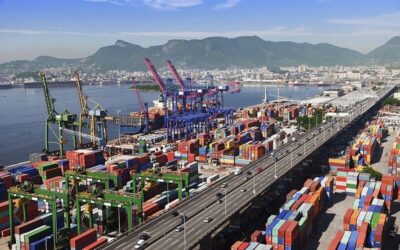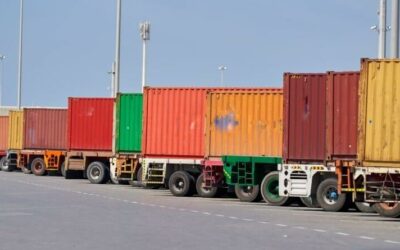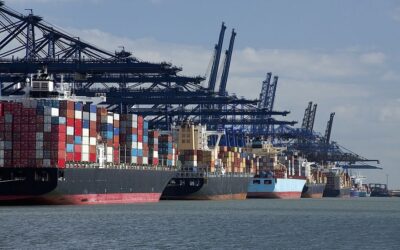Shipping From China to UAE : Transit Time, Cost, Procedure | The Ultimate Guide
The concept of commerce or trade was limited at the start, but now, the new era of global trade has a relatively mature value and supply chain since before. In recent times, China has been recognized as an emerging global superpower.
In a similar vein, UAE has become the main targeting hub with the world’s largest airport and logistics. It has been the logistics and re-export hub for the entire Middle East.
This guide will give you pivotal assistance for exporting your goods from China to UAE, different modes of transportation, cost, transit time, customs clearance in UAE, and major seaports and airports of both countries.
Okay! I know what you are thinking. You have some questions in your mind regarding shipping from China to the UAE. So. Let’s move on to this.
Table of Contents
What are the Different Options for Shipping from China to the UAE?
When it comes to moving cargo from point A to point B, most people aren’t aware of shipping their goods when asked about the shipping mode.
For this purpose, there are different types of modes of transportation for import and export goods. It could be air, land, sea, or railway. All these modes of transportation take cargo and deliver it to its final destination. It all depends on how much time you have, the type of goods, and your budget as well.
Shipping from China to UAE, you have only two options here:
- Airfreight
- Ocean Freight
Ocean Freight From China to UAE
In this case, you need to know about FCL and LCL, refer to the main modes of container shipment.
FCL: Full container loads books by one shipper under one shipment or part of a shipment from China to UAE. It has many advantages:
- LCL seems to have a longer transit time.
- LCL seems to be more pricey.
- Consolidation and deconsolidation aren’t needed.
- Damage or loss is less probable.
Containers are a handy way of transporting cargo to offshore subsidiaries.
They come in different sizes and dimensions like 20’ and 40’ foot containers.
LCL: Less than container load involves multiple shipper’s goods packed together. It allows you to maintain less quantity and more adaptable product inventory and is also suitable for both small packages or large cargo from China to UAE.
The benefit you can get with LCL is that you don’t have to wait to fill the whole container, but you don’t decide which type of cargo you share.
Air Freight From China to UAE
In case of urgency, You need to ship your cargo by air because it would be the best option, but you must be ready to collect a large bill for this fast and convenient service. Air cargo is transported on various types of aircraft such as passenger planes, cargo planes, aircraft charter, freighter, or helicopters.
What Would be the Cost to Ship Cargo from China to the UAE?
It all depends on your requirements and the nature of goods you want to ship such as perishable goods that need reefer containers or refrigeration. The factors mentioned below can affect the cost of the shipment:
- Cargo size
- Volume
- Prohibited goods
- Cargo weight
- Transit Time
You need to know this fact, air freight charges by weight and size of the shipment while in ocean freight, weight is not the big deal.
It could be explained better by this chart:
| Mode | Weight | Unit price | Total |
| Sea | 28,000 kg | 2850/40HC | 2850 |
| Air | 28,000 kg | $7/Kg | 7*28,000 |
Now, you know how cost affects when weight increases. When you pick air freight, it may assist you in calculating your air cargo cost.
On the other hand, a full standard container(20’ x 40’) is charged at a flat rate, and LCL is billed by cubic meters in ocean freight.
These are initial costs, actual costs will be calculated with inventory cost and warehouse fees, etc. This will be more expensive than the warehousing costs at the airport.
Remember, both modes of shipment will face customs procedures and destination fees when shipping internationally.
What Will be the Transit Time to Ship Cargo From China to UAE?
Air shipping is by far faster than sea shipping. As we know that sea freight takes weeks to arrive. On the other hand, airfreight goes fast to its destination but only a day or two in a week. Ocean freight can’t beat the speed in this case. The rates charged by different forwarders vary considerably.
Ocean Shipping is the right way of moving a huge volume of goods from China to the UAE. It is a cost-effective option as compared to airfreight. We can see that freight ships to China to the UAE :
By Air, → It takes 3-4 days
By Sea, → It takes 23- 30 days
In case of emergency or urgent delivery, your choice would be air freight because it’s faster, reliable, and secure than ocean freight.
Ocean Freight Transit Time from China to UAE
In the table below, we mentioned the details of average transit time(in days) from China ports to the UAE.
| Origin | Dubai | Sharjah | Abu Dhabi |
| Port of Shanghai | 28 | 28 | 28 |
| Port of Guangzhou | 24 | 24 | 25 |
| Port of Xiamen | 25 | 26 | — |
| Port of Qingdao | 29 | 29 | 30 |
| Port of Shekou | 24 | 24 | 25 |
| Port of Ningbo | 27 | 27 | 28 |
| Port of Chung Ching | 31 | 31 | 32 |
| Port of Zhongshan | 24 | 24 | 24 |
| Port of Chiwan | 23 | 23 | 24 |
| Port of Wuhan | 29 | 29 | 30 |
| Nansha Port | 24 | 24 | 25 |
| Port of Jiangyin | 28 | 28 | 29 |
| Huangpu Xingang Port | 24 | 24 | 25 |
| Port of Fuzhou | 26 | 26 | 27 |
| Port of Lianyungang | 29 | 29 | 30 |
Air Freight Transit Time from China to UAE
| Origin | Dubai | Abu Dhabi | Sharjah |
| Shanghai | 1-3 | 1-3 | 1-3 |
| Guangzhou | 1-2 | 1-2 | 1-2 |
| Beijing | 1-4 | 1-4 | 1-4 |
| Shenzhen | 1-3 | 1-3 | 1-3 |
| Yiwu | 1-4 | 1-4 | 1-4 |
The above table mentioned the air freight average transit time in days from China to the UAE.
What are the Major Seaports in China?
Following seaports in China ranked according to their traffic in terms of shipments in million tons and containers.
- Port of Shanghai
- Port of Shenzhen
- Port of Ningbo-Zhoushan
- Port of Guangzhou
- Port of Hongkong
- Port of Qingdao
- Port of Tianjin
Port of Shanghai
- The location is close to Shanghai. It is situated on the East China Sea and south of Hangzhou Bay.
- Built at the intersection of the Yangtze, Huangpu, and Qiantang rivers
- Handled 43.3 million TEU in 2019
- 514 Mt average cargo tonnage in 2016
- The largest port in the world comprises a deep-sea and a river port.
Port of Shenzhen
- The most transforming port in the region and divided into two areas:
- The Eastern port area: it’s located in the north of Dapeng Bay in South China
- The Western port area: It is connected to the Pearl river region and located to the east of Lingdingyang
- It has 40 berths, 50 global shipping lines, 51 berths dedicated for large vessels of 10,000 DWT, and the rest are divided like this:
- 18 containers berth
- 9 consignee berth
- 18 passenger ferry berth
- 23 non-production berth
- 27.7 million TEU container traffic in 2018
- 194.9Mt average cargo tonnage in 2018
Port of Ningbo-Zhoushan
- Located at Zhejiang on the coast of the East China sea across Shanghai on Hangzhou Bay
- 26.4 Mt container traffic in 2018
- 1.12 billion tons average cargo tonnage in 2018
- Deals in cargo shipment, raw materials, and manufactured goods
- Economic trade with more than 90 countries and 560 ports
- It’s a modern multi-purpose deep-water port
- 191 berths including 39 deep-water berths with 10,000 DWT
- It has a specialized crude oil processing facility as well as a specific terminal for 6th generation vessels.
Port of Guangzhou
- Located at Guangzhou the intersection of the three rivers of Dongjiang, Xinjiang, and Beijing in South China
- There are 4600 berths, 133 buoys, and 2359 anchorages at this port.
- Plays a vital role in industries located in Guangxi, Yunan, Guizhou, Sichuan, Hunan, and Jiangxi
- 21.9 million container traffic in 2018
- 600 Mt average cargo tonnage in 2018
- Connected with rail, road, air, and inland waterway
Port of Hongkong
- South China’s Victoria Harbor is home to a deepwater seaport.
- An economic entry point to China’s mainland
- It has 9 container terminals with 24 berths
- 19.6 million container traffic in 2018
- 258.5 Mt cargo tonnage in 2018
What are the Major Airports in China?
List of some major airports in China are:
- Beijing Capital International Airport (PEK)
- Shanghai Pudong International Airport (PVG)
- Guangzhou Baiyun International Airport (CAN)
- Chengdu Shuangliu International Airport (CTO)
- Kunming Changshui International Airport (KMG)
Beijing Capital International Airport (PEK)
- Airlines (81)
- Beijing (city)
- Destination (206)
- Terminal (3)
- Handles 2 Mt cargo yearly
- Handled 100.01 million passengers in 2019
Shanghai Pudong International Airport (PVG)
- Shanghai (city)
- Airlines (65)
- Destination (152)
- Terminal (2)
- Handled 74 million passengers in 2018
- Handled 3.76 Mt cargo in 2018
Guangzhou Baiyun International Airport (CAN)
- Guangzhou (city)
- Airlines (56)
- Destination (150)`
- Terminal (2)
- Handled 65.8 million passengers in 2019
- Handled 1.89 Mt cargo in 2018
Chengdu Shuangliu International Airport (CTO)
- Shuangliu-Wuhou (city)
- Airlines (39)
- Destination (108)
- Cargo Terminal (3) Total capacity (1.5 Mt)
- Handled 55.9 million passengers in 2019
- Handled 665,000t cargo in 2018
- Chengdu Airlines’ and Sichuan Airlines’ major hubs
Kunming Changshui International Airport (KMG)
- Kunming (city)
- Airlines (36)
- Destination (95)
- Terminal (1) with 3 layers on the ground and 3 underground
- Handled 428,000t cargo in 2018
- Handled 47.08 million passengers in 2018
What are the major Seaports in UAE?
Some major Seaports in UAE are:
- Port of Jebel Ali, Dubai
- Port of Mina Zayed, Abu Dhabi
- Port of Mina Rashid, Dubai
- Port of Mina Khalid, Sharjah
- Port Khalifa, Abu Dhabi
Port Of Jebel Ali, Dubai
- The largest gateway hub in the MiddleEast
- Capacity to handle 19.3 million TEU
- 21.1 million containers annual capacity
- 15 million TEU shipped in 2019
- Currently handles capacity 22.4 million TEUs
Port of Mina Zayed, Abu Dhabi
- Spread over 5.3 sqm area
- Handles up to 10 oceangoing vessels at a time
- Total 21 berths, a total berth length 4,375m
- Covering an area of more than 143,000sqm
Port of Mina Rashid, Dubai
- 1.5 million TEU capacity
- It possesses nine gantry cranes and a 1,500,000TEU capacity.
- A capacity to carter up to 25,000 passengers at once
Port of Mina Khalid, Sharjah
- 33 multi-purpose berths and 21 general cargo berths
- There are 21 berths for general, reefer, dry, liquid, and bulk cargoes.
- It has a copious amount of storage for goods
Port Khalifa
- It has an Inland Container Depot (ICD)
- Serves 25 shipping lines and direct links to 70 international destinations
- 12 largest ship-to-shore quay cranes
- 42 automated stacking cranes
- 20 straddle carriers
- 12 million tons of general cargo annually
What are the major Airports in the UAE?
There are 9 airports in the UAE and some major airports are listed below:
- Dubai International Airport (DXB)
- Abu Dhabi International Airport (AUH)
- Sharjah International Airport(SHJ)
- Al Maktoum International Airport (DWC)
Dubai International Airport (DXB)
- Dubai (city)
- Airlines (84)
- Destination (188)
- Terminal (3)
- Handled 88 million passengers in 2017
- Handled 2.65 Mt cargo in 2017
Abu Dhabi International Airport (AUH)
- Abu Dhabi (city)
- Airlines (58)
- Destination (87)
- Terminal (3)
- Handled 24.5 million passengers in 2016
- Handled 984,388 tons of cargo in 2016
Sharjah International Airport (SHJ)
- Sharjah (city)
- Airlines (16)
- Destination (78)
- Terminal (5)
- Handled 5.731 million passengers in 2018
- Handled 586,195 tonnes cargo in 2015
Al Maktoum International Airport (DWC)
- Dubai (city)
- Airlines (11)
- Destination (40)
- Terminal (1)
- Handled 1.63 million passengers in 2019
What Documents Do You Need for Customs Clearance in the UAE?
Customs Clearance is the process that allows shippers to export and import goods from and to transformed into two ways:
- Export Clearance
- Import Clearance
Custom clearance is mandatory in the freight shipping process. Rules and regulations are different for export and import. When you send shipments within your own business you would be an exporter or an importer.
Whereas, the seller takes the responsibility for the export customs clearance process while the buyer takes responsibility for the import customs clearance process.
Each country has its list of items permitted, restricted, and prohibited to import and export. Prohibited goods are those whose import or export is prohibited under the Common Customs Law, whereas restricted goods are those whose import or export is restricted under the Common Customs Law or any other regulation or law applicable in the State and may only be released with the approval of the competent authority.
Import Clearance Procedure in UAE
To pass customs on an import cargo arriving at a seaport or airport in the UAE, you’ll need the following documents:
- Bill of lading (sea channel)/ Airway Bill (air channel)
- Commercial Invoice
- Packaging list
- Certificate of origin
- Delivery order
You can also Read the Full Guide Here
Export Clearance Procedure in UAE
The following documentation is necessary for export cargo to a UAE seaport or airport:
- Export Invoice
- Packaging List
Under shared customs legislation, the Federal Customs Authority (FCA) draughts customs rules for each emirate in the UAE.
Which One is Better: Sea Freight VS Airfreight?
No doubt, ocean freight is the better option than airfreight unless your product has short shelf lives. If it is not in a hurry or in any urgency, this option is economical and good for your budget.
You can go through all processes with any reliable freight forwarder, like local transportation, export clearance, customs clearance, freight cost, insurance, and document delivery process.
Keep these things in mind, what your budget is, take your goods to the final destination, and have flexibility in arrival dates? Then, you have to choose the right mode of transportation which fully matches your requirements.
Why Choose Us?
We control your supply chain with all information on a dashboard, personalized just for your business. We have access to the best equipment to assist you with customized solutions for all types of commodities.
Our expert team will engage with you and understand what you are looking for to get shipped and help you with the best assistance at an economical cost.
Time is money, we save you both. Choose us, and we’ll get your products there.
The future depends on what you do today. Make the right move and let us help you move. Others strive to live up to the expectations we set. We consider logistics so that you don’t have to.






